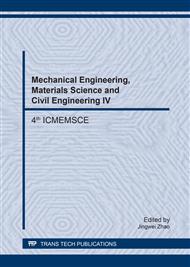p.212
p.218
p.223
p.229
p.234
p.240
p.245
p.252
p.257
Analysis on the Action of Oxidant in Chemical Mechanical Polishing of 304 Ultra-Thin Stainless Steel
Abstract:
The ultra-thin stainless steel sheet will be used in flexible displays for substrate material. The application of the substrate requires its surface very smooth, no defects and damage free. Chemical mechanical polishing (CMP) has been considered as a practical and irreplaceable planarization technology in the ultra precision machining of the flexible display substrate. In chemical mechanical polishing of ultra-thin stainless steel, the oxidant of polishing slurry has an important influence on the material removal rate (MRR). In this paper, the influences of oxidant in slurry on MRR and surface roughness had been studied in CMP of ultra-thin 304 stainless steel based on alumina (Al2O3) abrasive. The research results show that the oxidant of the hydrogen peroxide and the oxalic acid have the interaction in CMP 304 stainless steel and when using the only one oxidant in polishing slurry, the hydrogen peroxide or oxalic acid, the MRR is less than the maximum. The oxalic acid can provide a strong acidic environment to ensure the stability of the hydrogen peroxide in polishing slurry and to improve the MRR in CMP 304 stainless steel. The research results can provide the reference for studying the slurry in CMP of ultra-thin stainless steel.
Info:
Periodical:
Pages:
234-239
Citation:
Online since:
March 2017
Authors:
Price:
Сopyright:
© 2017 Trans Tech Publications Ltd. All Rights Reserved
Share:
Citation:


